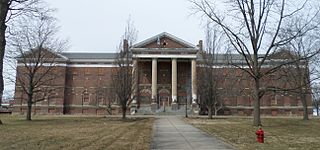
Spartanburg County is a county located on the northwestern border of the U.S. state of South Carolina. As of the 2020 census, the population was 327,997, making it the fifth-most populous county in South Carolina. Its county seat is Spartanburg. Spartanburg County is the largest county within the Spartanburg, SC Metropolitan Statistical Area, which is also included in the Greenville-Spartanburg-Anderson, SC Combined Statistical Area.

Gaffney is a city in and the seat of Cherokee County, South Carolina, United States, in the Upstate region of South Carolina. Gaffney is known as the "Peach Capital of South Carolina". The population was 12,539 at the 2010 census, with an estimated population of 12,609 in 2019. It is the principal city of the Gaffney, South Carolina, Micropolitan Statistical Area, which includes all of Cherokee County and which is further included in the greater Greenville-Spartanburg-Anderson, South Carolina Combined Statistical Area.

Spartanburg is a city in and the seat of Spartanburg County, South Carolina, United States. The city had a population of 38,732 as of the 2020 census, making it the 11th-most populous city in the state. The Office of Management and Budget (OMB) groups Spartanburg and Union counties together as the Spartanburg, SC Metropolitan Statistical Area.

The city of Union is the county seat of Union County, South Carolina, United States. The population was 8,393 at the 2010 census. It is the principal city of the Union Micropolitan Statistical Area, which includes all of Union County and which is further included in the greater Greenville-Spartanburg-Anderson, South Carolina Combined Statistical Area.

Wofford College is a private residential liberal arts college in Spartanburg, South Carolina, United States. Founded in 1854, it is one of the few four-year institutions in the southeastern United States founded before the American Civil War that still operates on its original campus. The 175-acre (71 ha) campus is a national arboretum.
Converse University is a private university in Spartanburg, South Carolina. It was established in 1889 by a group of Spartanburg residents and named after textile pioneer Dexter Edgar Converse. It was originally a women's college but now admits men.
The South Carolina Governor's School for the Arts & Humanities (SCGSAH) is a prestigious boarding school for the arts located in Greenville, South Carolina, United States. Founded in 1999 by Virginia Uldrick, the high school program provides pre-professional training in creative writing, dance, drama, film, music and visual arts to sophomores, juniors and seniors, in a master-apprentice, arts-centered community. The Governor's School also offers arts-intensive summer programs for 7th-through-11th-grade students.

Samuel Sloan was a Philadelphia-based architect and best-selling author of architecture books in the mid-19th century. He specialized in Italianate villas and country houses, churches, and institutional buildings. His most famous building—the octagonal mansion "Longwood" in Natchez, Mississippi—is unfinished; construction was abandoned during the American Civil War.

Minnesota State Academy for the Blind (MSAB) (formerly known as the Braille and Sight Saving School) is a public school in Faribault, Minnesota, United States. Its mission is the education and life education of blind, visually impaired, and deaf-blind learners from birth to age 21. The school has a residential option program and provides 24-hour programming including Braille, independent travel, assistive technologies, and individualized educational services. Students often have multiple disabilities and come from all regions of the state.

The Virginia School for the Deaf and the Blind, located in Staunton, Virginia, United States, is an institution for educating deaf and blind children, first established in 1839 by an act of the Virginia General Assembly. The school accepts children aged between 2 and 22 and provides residential accommodation for those students aged 5 and over who live outside a 35-mile (56 km) radius of the school

The Minnesota State Academy for the Deaf (MSAD) is a public residential school serving deaf children in Minnesota, United States. It is one of two Minnesota State Academies in Faribault and operated by the state for particular student populations.

Spartanburg High School is a public high school in Spartanburg, South Carolina, United States. It is part of Spartanburg County School District 7.

The Nebraska School for the Deaf, or NSD, was a residential school for Deaf students in kindergarten through Grade Twelve at 3223 North 45th Street in Omaha, Nebraska, United States. Founded in 1869, the school closed in 1998. The school attracted national attention throughout its existence, first for controversial teaching practices and then for its closure.
William Augustus Edwards, also known as William A. Edwards was an Atlanta-based American architect renowned for the educational buildings, courthouses and other public and private buildings that he designed in Florida, Georgia and his native South Carolina. More than 25 of his works have been listed on the National Register of Historic Places.

The North Carolina School for the Deaf (NCSD) is a state-supported residential school for deaf children established in 1894, in Morganton, North Carolina, US.

Edward Culliatt Jones was an American architect from Charleston, South Carolina. A number of his works are listed on the U.S. National Register of Historic Places, and two are further designated as U.S. National Historic Landmarks. His works include the following :
Ray Robinson Williams was a blind lawyer in Greenville, South Carolina and a South Carolina state senator, 1940–1953.

The Michigan School for the Blind (MSB) was a state-operated school for blind children in Michigan.

Governor Morehead School (GMS), formerly North Carolina State School for the Blind and Deaf, is a K–12 public school for the blind in Raleigh, North Carolina. In the era of de jure educational segregation in the United States, it served blind people of all races and deaf black people.


















